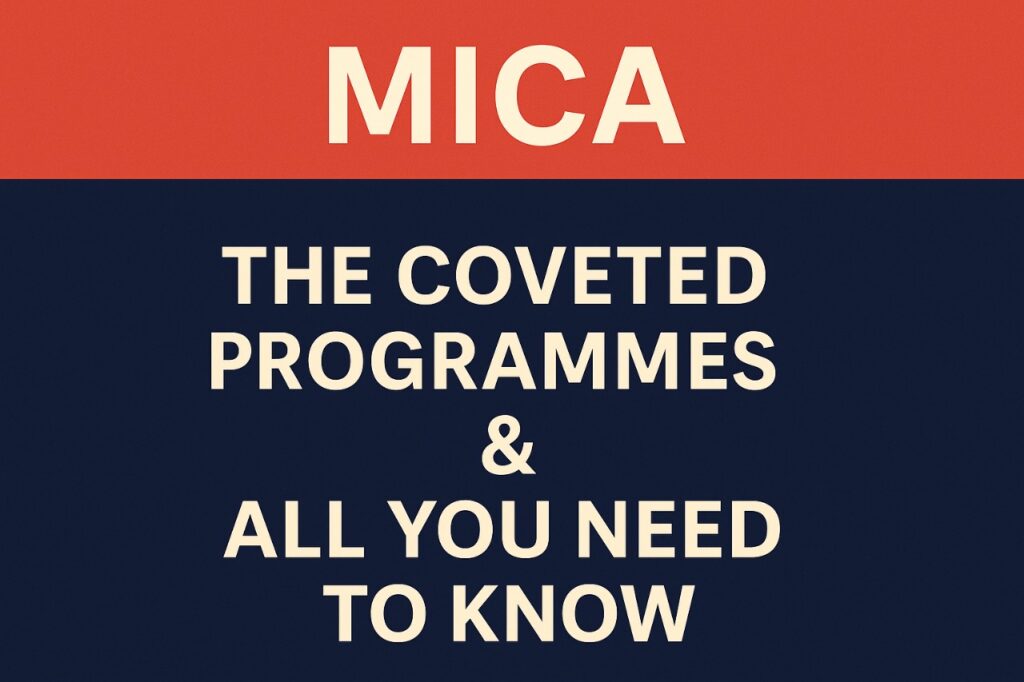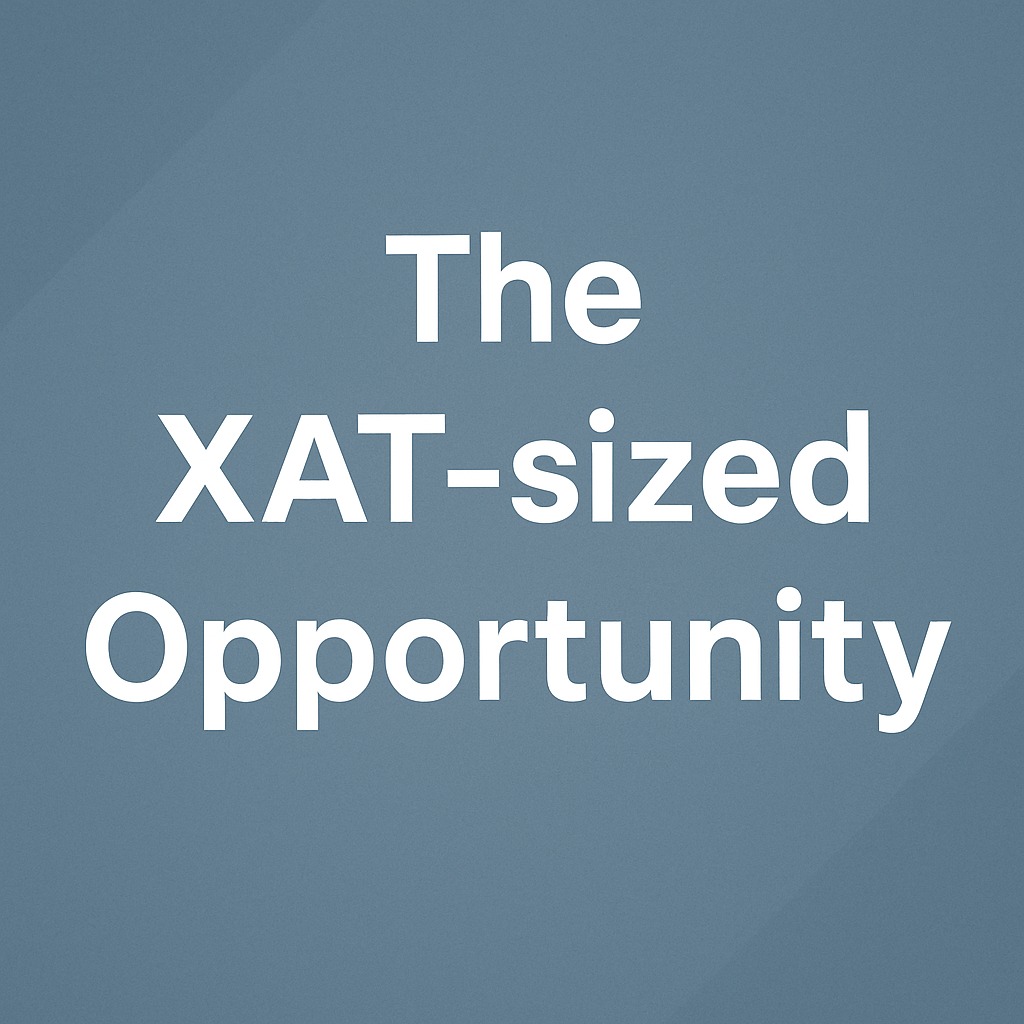MICA – The coveted programmes & All you need to know

MICA (formerly known as Mudra Institute of Communications, Ahmedabad) stands out as India’s premier B-school for Strategic Marketing and Communication. Established in 1991, MICA has consistently evolved to stay ahead in the rapidly changing domains of marketing, media, digital communication, and branding. As the only residential institute in India dedicated to creating leadership in strategic marketing and communication, MICA blends creativity with business strategy like no other. Legacy and Evolution Founded by the Mudra Foundation, MICA was envisioned as a hub for innovation in communication. Over the years, it has developed into a globally recognized institution, known for its focus on creativity, consumer insight, and digital transformation. With over three decades of experience, MICA has built a strong alumni network, many of whom now lead brand, digital, and media strategy roles across top global firms. MBA Programme Highlights: PGDM-C and PGDM MICA offers two flagship full-time residential programmes: PGDM-C (Post Graduate Diploma in Management – Communications): A unique course that focuses on Strategic Marketing and Communication, combining core management disciplines with insights into media, advertising, and digital marketing. PGDM (General Management): Launched in recent years, this programme retains MICA’s strong foundation in marketing but is structured more broadly for general management aspirants. Both programs are AICTE-approved and span two years. Students can choose from specializations in Brand Management, Media Management, Digital Communication Management, Marketing Analytics, and Advertising. Faculty and Pedagogy MICA boasts a world-class faculty with a rich blend of academic rigor and industry experience. Professors are active in research, consulting, and media discourse, ensuring that classroom discussions are always contemporary. Faculty members bring expertise from IITs, IIMs, global universities, and multinational corporations. Courses are taught using a mix of case studies, live projects, workshops, simulations, and lectures. Batch Profile (2023-2025) MICA values diversity in background, thought, and experience. The batch typically features: Class Size: ~180-200 students per programme Gender Diversity: ~55% female, 45% male Educational Background: Mix of engineers, commerce, arts, media, and management graduates Work Experience: 50-60% freshers, rest with work experience across sectors like IT, media, startups, consulting, and FMCG This blend fosters peer learning and an inclusive culture of innovation. Placements and Career Opportunities MICA enjoys robust placements driven by its niche positioning in marketing and communication. Key highlights from the latest placement season: Average CTC: ~INR 20.1 LPA Highest CTC: INR 36+ LPA Top Recruiters: Google, Amazon, Reckitt, Tata Digital, L’Oréal, P&G, Accenture, GroupM, Flipkart, Deloitte, HUL, and more Roles Offered: Brand Manager, Digital Marketing Manager, Media Strategist, Product Manager, Consumer Insights Analyst, Marketing Analyst, Content Strategist The alumni network actively supports placement, mentoring, and career growth. Admission Process and Safe Scores Admissions to MICA’s PGDM and PGDM-C are via MICAT, which is a two-part admission process: Eligibility: Bachelor’s degree in any discipline + a valid score in at least one of the following exams: CAT (Common Admission Test) XAT (Xavier Aptitude Test) GMAT (Graduate Management Admission Test) MICAT: A unique entrance exam that tests: Divergent Thinking and Creativity Written Communication Psychometric Analysis Quantitative & Verbal Skills General Awareness (with focus on media/marketing) Selection Process: Shortlisting based on CAT/XAT/GMAT + MICAT Group Exercise (GE) and Personal Interview (PI) Safe Scores (Indicative, based on past trends): CAT/XAT/GMAT: 85+ percentile MICAT: Scoring 50-60 percentile (scaled) with strong performance in GE-PI gives a solid chance MICA places significant emphasis on creativity and clarity of thought rather than just aptitude scores. Why students pick MICA? Unmatched focus on marketing, branding, and communication Pedagogical innovation and industry-aligned curriculum Global exposure through exchange programs and live projects Strong industry connect and consistently high ROI A vibrant campus culture that nurtures creativity and leadership For students who aspire to lead in the evolving world of marketing and media, MICA offers the perfect launchpad.
The XAT sized Opportunity

XAT is the second most popular exam after CAT in India purely because it has the highest number of top B-School Seats. Here’s a concise, easy‑to‑grasp rundown of everything from the exam structure to top PGDM/HRM colleges, their seat intakes, fees, and placement highlights to let an aspirant understand why XAT is so big and how to get started. XAT 2026: The Basics When & Who Typically scheduled first Sunday of January each year (so expect early January 2026). Conducted by XLRI – Xavier School of Management, Jamshedpur. Registration Window & Fee Opens mid‑July through early December of the preceding year. Exam fee around ₹ 2,200, with an extra ₹ 200 for each XLRI programme you apply to. Eligibility Any graduate (or final‑year student) from a recognised university (minimum 3‑year degree). No minimum percentage or age limit. Exam Pattern Duration: 180 minutes total Part 1 (170 min): Quantitative Ability & Data Interpretation, Verbal & Logical Ability, Decision Making (approx. 75 questions) Part 2 (10 min): General Knowledge (20 questions; for profile but not counted in percentile) Marking Scheme: +1 for correct, –0.25 for wrong; penalty for excessive unattempted questions. Top PGDM/HRM Colleges Accepting XAT Below is a snapshot of leading institutes that use XAT scores for admissions. For XLRI Jamshedpur, only the two‑year PGDM programmes are listed (Business Management and Human Resource Management). Institute (Campus) Seats Total Fees (₹) Avg. CTC (LPA) Highest CTC (LPA) XLRI Jamshedpur 420 25.8 L 27.07 75 • PGDM – Business Management (BM) 240 (included above) • PGDM – Human Resource Management (HRM) 180 SPJIMR Mumbai (PGDM) 480 23.4 L (est.) ~ 26 ~ 31 XIM Bhubaneswar (MBA‑BM) ~ 350 19.95 L 19.53 30 MICA Ahmedabad (PGDM‑C) 240 21 L 19.21 35.5 TAPMI Manipal (PGDM) 630 17.10 L 13.84 32.02 IBS Hyderabad (PGDM) 1,320 16.02 L 9.71 36.76 LIBA Chennai (PGDM) 240 19.10 L 11.20 21 IMT Ghaziabad (PGDM) 960 21.53 L 17.20 62.86 FORE School of Mgmt, Delhi (PGDM) 480 20.77 L ~ 12.5 ~ 20 GIM Goa (PGDM) 240 18 L (est.) ~ 14 ~ 25 IRMA Anand (PGDM‑RM) 240 17.5 L (est.) ~ 12 ~ 27 Great Lakes Chennai (PGPM) 300 20 L (est.) ~ 15 ~ 30 KJ Somaiya, Mumbai (PGDM) 240 19 L (est.) ~ 12 20 XLRI Delhi is the latest entrant with over 180 seats XAT 2025 Cut-Offs: What You Need to Score for Top B-Schools Here’s a simplified breakdown of the overall XAT 2025 cut-offs for leading management institutes. While XLRI uses detailed criteria including gender and academic background, most other colleges work with general overall percentiles. Use this as a guide to set your target score. XLRI Jamshedpur One of the most prestigious B-schools in India, XLRI offers two flagship programs – PGDM in Business Management (BM) and PGDM in Human Resource Management (HRM). Here’s how the cut-offs looked in 2025: PGDM – BM (Male Candidates): 96 percentile and above PGDM – BM (Female Candidates): 91 percentile and above PGDM – HRM (Male Candidates): 95 percentile and above PGDM – HRM (Female Candidates): 90 percentile and above XLRI sets different cut-offs for male and female candidates to promote gender diversity. Additionally, academic discipline may also impact shortlisting in HRM (with engineers facing higher cut-offs). Other Top B-Schools and XAT Cut-Offs (2025) Here’s how some of the other top B-schools fared in terms of XAT cut-off percentiles: Institute Programme Expected Cut-Off (Overall Percentile) SPJIMR, Mumbai PGDM 93 – 95 percentile XIM Bhubaneswar MBA – BM 88 – 91 percentile IMT Ghaziabad PGDM 90 – 92 percentile GIM, Goa PGDM 85 – 90 percentile TAPMI, Manipal PGDM 80 – 85 percentile IRMA, Anand PGDM – Rural Mgmt 80 – 85 percentile MICA, Ahmedabad PGDM – Communications 80 – 85 percentile Great Lakes, Chennai PGPM 80 – 85 percentile LIBA, Chennai PGDM 80 – 85 percentile KJ Somaiya, Mumbai PGDM 80 – 85 percentile ✅ Key Takeaways XLRI remains the toughest nut to crack, with cut-offs well above 90 percentile for all programs. SPJIMR, IMT, and XIMB are next in line, requiring strong overall performance across sections. MICA, IRMA, GIM, and TAPMI offer great opportunities for aspirants in the 80–85 percentile range. KJ Somaiya, LIBA, and Great Lakes are solid bets for well-rounded profiles just below the top cut-off range. How to Plan Your XAT 2026 Journey Understand Your Fit General Management: IMT, FORE, TAPMI, XIMB, IBS HR & OD: XLRI HRM, LIBA, SPJIMR Marketing & Communications: MICA, Great Lakes Rural & Dev. Mgmt: IRMA, XIMB (RD) Set Your Target Percentile Aim for 95+ to access top‑tier programmes (XLRI BM/HRM, SPJIMR). 85–90 for premier institutes like XIMB, MICA, IMT. 80+ to unlock strong niche schools (IRMA, Great Lakes). Build a Balanced Application List Shortlist 6–8 programmes across “super‑elite,” “premier,” and “niche‑specialist” tiers. Consider fees vs. average CTC to estimate ROI and payback period. Master the Exam Pattern Allocate practice time to Decision Making and VA‑LR—they’re unique to XAT. Regularly solve past papers under timed conditions. Keep abreast of current affairs for the GK section. Polish Your Profile GMAT/XAT is just one filter—focus on academics, work experience, and extracurriculars for GD‑PI shortlists. Stay Consistent Draft a study plan covering all sections with weekly milestones. Join peer‑study groups or coaching if you need structured guidance.
